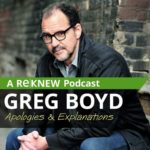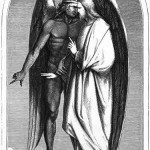We run our website the way we wished the whole internet worked: we provide high quality original content with no ads. We are funded solely by your direct support. Please consider supporting this project.

Two Questions to Unlock Violent Divine Portraits
There are two basic questions that help us to interpret what is going on in the violent portraits of God in the Old Testament, as I propose in Crucifixion of the Warrior God.
The First Question: What does the “God-breathed” revelation of the cross teach us about the nature of God’s “breathing”?
God “breathed” his supreme revelation on the cross by both acting toward us and by allowing others to act toward him. Because God honors the personhood of others, and because he therefore works by means of the influential power of the cross (1 Cor 1:18) rather than by exerting coercive power, God’s “breathing” is a dialectical rather than a unilateral process.
This cross-centered, dialectical understanding of the way God “breathes” should shape how we interpret the way that God “breathed” the Old Testament witness. We must read it with the awareness that it reflects both God acting toward us, insofar as God’s people at that time could receive it, as well as God humbly allowing others to act toward him, insofar as God had to accommodate his people’s fallen and culturally-conditioned hearts and minds. We must read the written witness of the OT knowing that portraits of God will display the same beautiful character as is revealed on the cross insofar as they reflect the former, but they will reflect the same ugliness of sin that is revealed on the cross insofar as they reflect the latter.
In this light, the OT’s violent portraits of God can be understood as testaments to the truth that God has always been willing to humbly stoop to bear the sin of his people and to thereby take on a literary semblance that mirrors the ugliness of this sin, just as he did in a historical way on the cross.
The Second Question: How does a guilty-appearing, godforsaken, crucified criminal become the definitive revelation of God for us?
It is not what everyone can see on the surface of the crucifixion that reveals God. Rather it is only when we by faith look through the surface of this event that it becomes the definitive revelation of God for us. Only by faith can we discern the Creator stooping an infinite distance to become this guilty-appearing, godforsaken, crucified criminal.
Since the God who “breathed” this paradigmatic revelation is the same God who “breathed” his written witness to this revelation, we should read Scripture expecting that there will be times when the revelatory content of a portrait of God is to be found not on its surface, but in its depth. The first can be understood by straightforward exegesis, but the second calls for faith to discern the humble, loving condescension of God.
However, we can only interpret the OT’s violent portraits in this sin-bearing way if we place our compete trust in the character of God revealed on the cross. If we suspect that God has a dark side and is capable of doing the monstrous things that the OT authors attribute to him, we will mistake the “shadow” for the “reality” (Col 2:17; Heb 10:1).
To put it another way, if we fail to place our trust in the revelation of the crucified Christ, we are trading the unclouded revelation of the Son, who alone is the “radiance of God’s glory” (Heb 1:3) for the cloudy perspective of ancient authors who could only catch “glimpses of truth” (Heb 1:1).
Only the slain lamb unlocks the secret of how macabre portraits of God point to him.
—Adapted from Crucifixion of the Warrior God, pages 1250-1252
Photo credit: Vitor Sá Photo via Visual Hunt / CC BY-NC-ND
Category: General
Tags: Crucifixion of the Warrior God, Cruciform Theology, OT Violence
Topics: Interpreting Violent Pictures and Troubling Behaviors
Related Reading

How NOT to be Christ-Centered: A Review of God With Us – Part III
In the previous two posts on Oliphint’s God With Us, we’ve seen that Oliphint is trying to reframe divine accommodations in a Christ-centered way, but that what he means by this is not that he is going to derive his understanding of God from Christ, but that he is going to use the “hypostatic union”…

Podcast: How Do We Understand the Flood Through the Lens of the Cross?
Greg dives deep into the flood, to make sense of it through the lens of Christ on the cross. http://traffic.libsyn.com/askgregboyd/Episode_0087.mp3

Christ-Centered or Cross-Centered?
The Christocentric Movement Thanks largely to the work of Karl Barth, we have over the last half-century witnessed an increasing number of theologians advocating some form of a Christ-centered (or, to use a fancier theological term, a “Christocentric”) theology. Never has this Christocentric clamor a been louder than right now. There are a plethora of…

How Should We Read the Imprecatory Psalms?
Greg talks about reading the imprecatory Psalms (Psalms that invoke judgment, calamity, or curses, upon one’s enemies or those perceived as the enemies of God). http://traffic.libsyn.com/askgregboyd/Episode_0049.mp3

The God Who Stoops
The way that one imagines God can be thought of along the lines of a Rorschach test. That is, I submit that the way a person imagines and experiences God says at least as much about that person as it does God. The more estranged people are from God, the more their knowledge of him is…

What Does Spiritual Warfare Have To Do with the Cross?
Last week, we covered a few posts on the nature of the Atonement and the Christus Victor view. The following continues this theme, specifically looking the motif of spiritual warfare and how it relates to Christ’s work on the cross. This is an adaptation from Greg’s article in The Nature of the Atonement: Four Views. …
